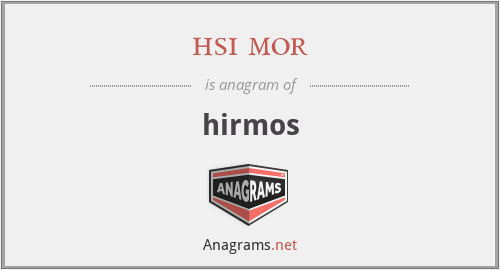What anagrams are available for hirmos?
This page is about an anagram for the word hsi mor that can be used in word games, puzzles, trivia and other crossword based board games.
hsi mor
Translation
Find a translation for hsi mor in other languages:
Select another language:
- - Select -
- 简体中文 (Chinese - Simplified)
- 繁體中文 (Chinese - Traditional)
- Español (Spanish)
- Esperanto (Esperanto)
- 日本語 (Japanese)
- Português (Portuguese)
- Deutsch (German)
- العربية (Arabic)
- Français (French)
- Русский (Russian)
- ಕನ್ನಡ (Kannada)
- 한국어 (Korean)
- עברית (Hebrew)
- Gaeilge (Irish)
- Українська (Ukrainian)
- اردو (Urdu)
- Magyar (Hungarian)
- मानक हिन्दी (Hindi)
- Indonesia (Indonesian)
- Italiano (Italian)
- தமிழ் (Tamil)
- Türkçe (Turkish)
- తెలుగు (Telugu)
- ภาษาไทย (Thai)
- Tiếng Việt (Vietnamese)
- Čeština (Czech)
- Polski (Polish)
- Bahasa Indonesia (Indonesian)
- Românește (Romanian)
- Nederlands (Dutch)
- Ελληνικά (Greek)
- Latinum (Latin)
- Svenska (Swedish)
- Dansk (Danish)
- Suomi (Finnish)
- فارسی (Persian)
- ייִדיש (Yiddish)
- հայերեն (Armenian)
- Norsk (Norwegian)
- English (English)
Definition
What does hirmos mean?
- Hirmos
- The irmos (or heirmos from Koinē Greek: εἱρμός) in the Byzantine liturgical tradition is the initial troparion of an ode of a canon. The meter and melody of an irmos is followed by the remaining troparia of the ode; when more than one canon is used (as is typical at matins), only the first canon's irmos is sung, but the irmoi of the subsequent canons must be known in order to determine an ode's melody and so, even in canons where it is known that the irmos is never sung, the irmos is nonetheless specified. Note that in the Russian tradition, often only the irmos is sung, the rest of the ode simply being read; in Greek parishes, often the remaining troparia are simply eliminated, but in non-Russian traditions, all troparia of a canon are sung The term comes from the Greek verb "to tie, link" meaning that it poetically connects the Biblical ode to the subject of the canon.Because the irmos presents a rhythmic and melodic pattern for the troparia which follow, "irmos" gives its name to the irmologic forms of Byzantine chant. At the end of an ode, the irmos may be repeated, or another irmos may be prescribed to be sung to return to the original biblical theme this is called the katavasia.
Embed
Citation
Use the citation below to add this anagram to your bibliography:
Style:MLAChicagoAPA
"hsi mor." Anagrams.net. STANDS4 LLC, 2024. Web. 9 May 2024. <https://www.anagrams.net/term/5996069>.



Discuss this hirmos anagram with the community:
Report Comment
We're doing our best to make sure our content is useful, accurate and safe.
If by any chance you spot an inappropriate comment while navigating through our website please use this form to let us know, and we'll take care of it shortly.
Attachment
You need to be logged in to favorite.
Log In